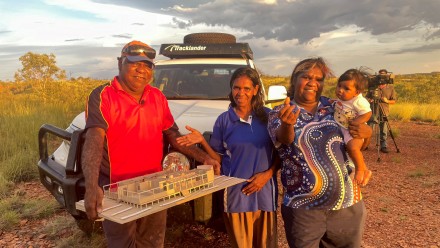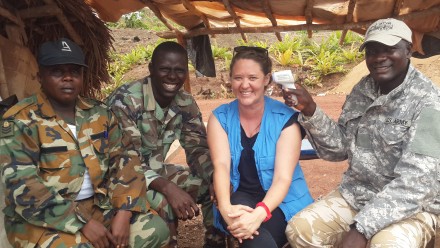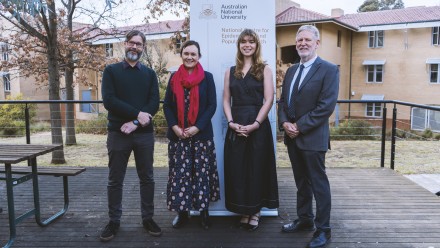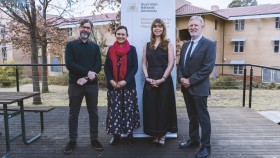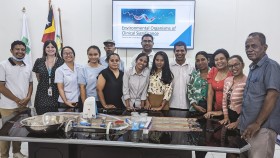Washing away disease
Share
ANU researchers are helping to eliminate the scourge of intestinal worms in Myanmar, as AMANDA COX reports.
Like many places around the world, an early morning scene in the rural township of Phyu is filled with smiling children walking eagerly to school
They are dressed in the national school uniform of Myanmar – green longyi skirts for the girls and green shorts or green longyis for the boys – as they pass rice fields and irrigation channels.
But this scene is not as idyllic as it seems: invisible worm eggs are hiding in the soil, toilets and food, with the result three in every four of these children are infected.
According to the World Health Organization, more than 600 million school-aged children are infected with intestinal worms worldwide.
Dr Eindra Aung from the ANU Research School of Population Health says the infections impact children in poorest areas the most, resulting in reduced growth rates and poor intellectual development.
The problem is made worse by poor nutrition because so much of the children’s limited nutrition goes to the worms.
“Children with long-term infections may not have the energy and cognitive ability to fully engage in their studies,” Aung says.
She has seen firsthand the impact of worm infections on schoolchildren in Myanmar.
“Many of them seem to be smaller than children of the same age in other South East Asian countries,” she says.
To address this global problem, researchers at ANU in collaboration with the University of Queensland and the QIMR Berghofer Medical Research Institute have developed an educational program using an animated cartoon to educate schoolchildren about hygiene.
The video tells the story of a young boy and girl with magic glasses that reveal worms inside their friends as well as worm eggs hidden throughout their village.
Leader of the magic glasses research group at ANU, Associate Professor Darren Gray, says the program fits nicely into school-based deworming programs.
“You can treat the kids and then show them the video to teach them how to prevent infection,” he says.
Aung says the program was a success in China. “But if we want to do a project on that scale in Myanmar, we need to establish and maintain a collaboration first,” she says.
And this is exactly what the ANU researcher has been doing.
She visited Myanmar several times in 2016 to plan, prepare and conduct a pilot study on intestinal worm infections among schoolchildren.
In doing so she has travelled on an incredible journey, ending up working with the university just blocks away from where she grew up.
Her journey into health work started in Myanmar where she graduated with a degree in medicine. However, because she preferred to "look at things in a bigger picture", she moved to Australia to study a Master of International Public Health.
She says that moving to Sydney from Myanmar – where her education was put on hold due to “brave students protesting the dictatorship” – was a life-changing experience, but it wasn’t until she began her public health career that she witnessed extreme poverty first hand.
“After my Master degree I went to Thailand, working for World Vision to prevent spreading of HIV infection among Burmese migrants,” she says.
Aung was working in Phuket when the 2004 tsunami hit, killing more than 230,000 people across 14 countries.
“We were the only ones who were giving assistance to migrant workers in the immediate aftermath,” she recalls.
Along with her medical training, she has on-the-ground experience with the health issues impacting communities in Myanmar.
“After Cyclone Nargis in 2008, more than 135,000 people died in Myanmar. I went back and did relief work, leading the health team for World Vision’s cyclone response.”
Through her experience in public health, Aung became passionate about the power of communication to bring about behavioural change – and this is where the magic glasses program comes in.
In March 2016, Dr Aung and Associate Professor Gray initiated a pilot study to test for intestinal worms in the rural township of Phyu and nearby villages, located 185 km north of Yangon.
They had a shoestring budget to complete hygiene behaviour surveys and to test stool samples for intestinal worms in around 300 children.
“We only had $6,000 for running the program and I could only do it because I was living at home in Yangon for part of it,” Aung says.
But while it may take a village to raise a child, running a public health research program requires a higher level of collaboration, including between government, universities and communities.
Aung has been overwhelmed with the support she received to help her successfully complete the pilot project. This included support from the University of Yangon, the Department of Medical Research and the Ministry of Health and Sports in Myanmar. Local health workers and school teachers also helped out with enthusiasm.
“It was a fantastic collaboration,” she says.
The results from the stool samples, however, were not so great. Early results indicate around 75 per cent of the children tested are infected with worms.
Now Gray and Aung are working to formalise collaborations in Myanmar, creating the foundation needed to run a larger scale research program.
For their trips to Myanmar they have received funding from the Government Partnerships for Development Program, run by the ANU Myanmar Research Centre and funded by the Department of Foreign Affairs and Trade.
Under the program, ANU researchers are collaborating with the University of Yangon on topics as diverse as earthquakes, library management and building a science circus in Myanmar.
Aung says the program is a great success.
“I really enjoyed working with the staff from the University of Yangon, we had a great team, we learned together. But there is a still a lot of work to do.”
Like so many things in Myanmar at the moment, although there may be a long road ahead, things are moving in the right direction.





